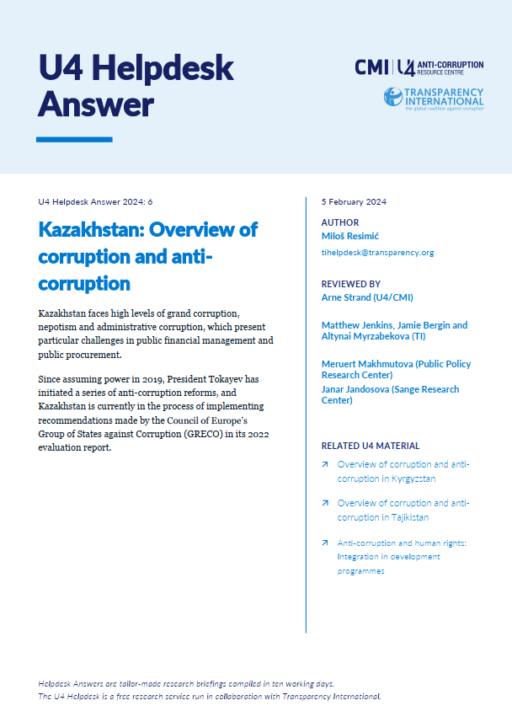
This Anti-Corruption Helpdesk brief was produced in response to a query from a U4 Partner Agency. The U4 Helpdesk is operated by Transparency International in collaboration with the U4 Anti-Corruption Resource Centre based at the Chr. Michelsen Institute.
Query
Please provide an overview of corruption and anti-corruption efforts in Kazakhstan.
Summary
Kazakhstan faces high levels of grand corruption, nepotism and administrative corruption, which present particular challenges in public financial management and public procurement.
Since assuming power in 2019, President Tokayev has initiated a series of anti-corruption reforms, and Kazakhstan is currently in the process of implementing recommendations made by the Council of Europe’s Group of States against Corruption (GRECO) in its 2022 evaluation report.
Content
- Background
- Extent of corruption
- Forms of corruption
- Grand corruption
- Nepotism
- Administrative corruption
- Drivers of corruption in the public financial management cycle
- Main sectors and areas affected by corruption
- Police and military
- Justice sector
- Lower-level government administration
- Legal and institutional anti-corruption framework
- International conventions and initiatives
- Domestic legal framework
- Institutional framework
- Other stakeholders References
Main Points
— Grand corruption, nepotism and administrative corruption are all evident in Kazakhstan.
— Important anti-corruption reforms have been launched since the 2019 power shift and unrest in January 2022. There is also evidence to suggest that the state has taken measures to implement many of the recommendations contained in the 2022 GRECO report.
— The public financial management cycle remains vulnerable to corruption, primarily due to a lack of transparency, inadequate oversight of the quasi-public sector and low competitiveness in public procurement.
— Corruption is prevalent in the executive branch, law enforcement, local government administration, the education system and the judiciary.
— Despite political constraints on civil society and journalists, coalitions of civil society organisations and independent media outlets have been active in monitoring and highlighting corruption risks in public contracting.
Authors
Miloš Resimić
Reviewed by
Arne Strand (U4/CMI)
Matthew Jenkins, Jamie Bergin and Altynai Myrzabekova (TI)
Meruert Makhmutova (Public Policy Research Center)
Janar Jandosova (Sange Research Center)
Date
18/02/2024
Tags
 Download PDF
Download PDF
